::
Grilled Fish Packages
Adapted from Diana Kennedy’s Pescado Sarandeado recipe
in The Art of Mexican Cooking, Bantam, 1989
 I looked through Diana Kennedy’s books for an interesting fish recipe for Saturday night dinner and zeroed in on Pescado Sarandeado (page 208): a whole 3 ½ lb. fish, stuffed, wrapped with tortillas and grilled. My guests and I loved the way the edges of the tortillas got brown and crispy, the fish stayed moist, and the stuffing added great flavor. The only issues were fish skin sticking to the tortillas and the foil, and dealing with all the little fish bones. What if you made it with thick fillets, we wondered. So I tried in on Sunday with codfish. Perfect. Is this dish more like a fish taco in foil, or a fish tamale? You tell me. And for my husband who doesn’t eat fish I made a veggie version with the stuffing only, wrapped in tortillas. His new favorite food.
I looked through Diana Kennedy’s books for an interesting fish recipe for Saturday night dinner and zeroed in on Pescado Sarandeado (page 208): a whole 3 ½ lb. fish, stuffed, wrapped with tortillas and grilled. My guests and I loved the way the edges of the tortillas got brown and crispy, the fish stayed moist, and the stuffing added great flavor. The only issues were fish skin sticking to the tortillas and the foil, and dealing with all the little fish bones. What if you made it with thick fillets, we wondered. So I tried in on Sunday with codfish. Perfect. Is this dish more like a fish taco in foil, or a fish tamale? You tell me. And for my husband who doesn’t eat fish I made a veggie version with the stuffing only, wrapped in tortillas. His new favorite food.
3 medium-size red boiling potatoes
1 tsp white vinegar
3 cloves garlic, chopped
2 large ripe tomatoes, diced, skin left on
½ cup pimento-stuffed green olives, roughly chopped
2 canned serrano chiles en escabache, seeds removed, sliced in lengthwise strips
2 Tb capers
¼ cup minced flat-leaf parsley
9 corn tortillas
4 6-oz fillets of cod or similar fish, as thick and compact as possible
1 lime, cut in wedges
4 large rectangles of nonstick aluminum foil
light olive oil for sautéeing
Peel and quarter the potatoes, drop them into a pan of salted boiling water, add vinegar and simmer until not quite tender. Drain and rinse in cool water. (Note: Diana’s recipe also called for 1/2 lb. parboiled carrots, which I left out because our appetizer—see below—was very carrot-y, and I added the capers.)

The filling, with the potatoes absorbing the sauce, is very Diana. It could be a fine side dish on its own. Or a vegetarian main dish, with the addition of carrots and/or peas and string beans.
In the meantime, heat 3 Tb. oil in a large frying pan. Sauté the garlic, tomatoes and olives for about 5 minutes. Dice the potatoes (should be still warm) and add them with the chili strips to the tomato mixture. Sauté for another 5 minutes until most of the sauce is absorbed by the potatoes. Stir in the capers and parsley. Salt lightly; the olives and capers are salty.
Heat 3 Tb. oil in a smaller frying pan and quickly fry the tortillas until just softened, one at a time, turning over once. Drain on paper towels. Add more oil as necessary to finish the batch.
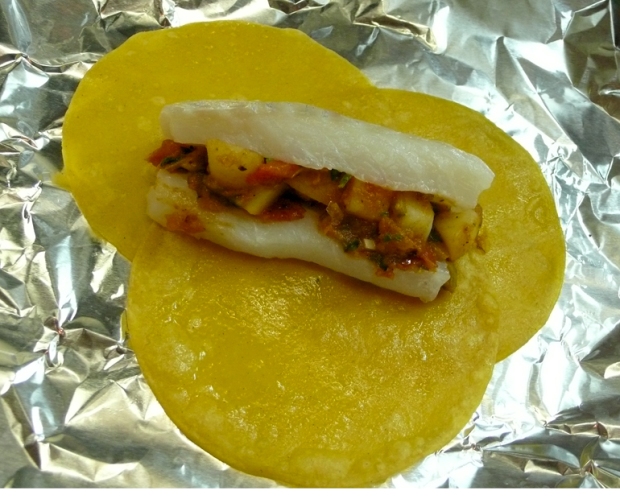
The tortillas has been briefly friend in hot oil until pliable and the fish package is ready to wrap, first in the tortillas and then tightly in the foil before placing on the grill.
To make each package, center 3 tortillas on a piece of foil. Take a piece of fish and butterfly it—slice it lengthwise almost all the way through so you can open it up. Sprinkle it with lime juice, salt and pepper lightly. Fill it with potato mixture and close it. Place it on the tortillas and wrap it with them. It’s okay if it doesn’t make a neat package. Wrap with the foil, sealing it lengthwise and on the ends.
Heat a grill to medium (350 degrees for gas grill). Place fish packages on the grill and cook 20 minutes. Open the foil and serve with lime wedges. Romaine and radish salad on the side.
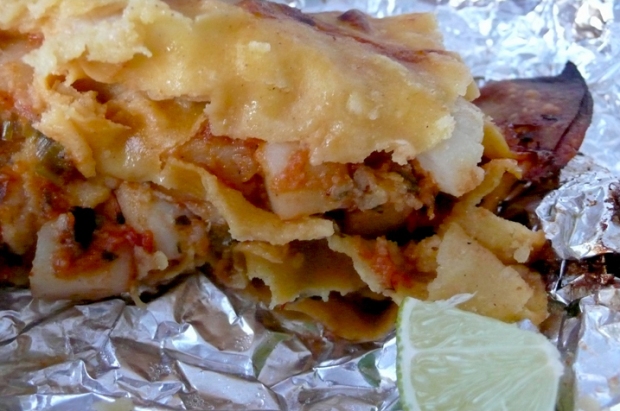
The results are messy and delicious, sort of like a fish tamale with crispy edges. The recipe completely transformed the crummy factory tortillas I used.
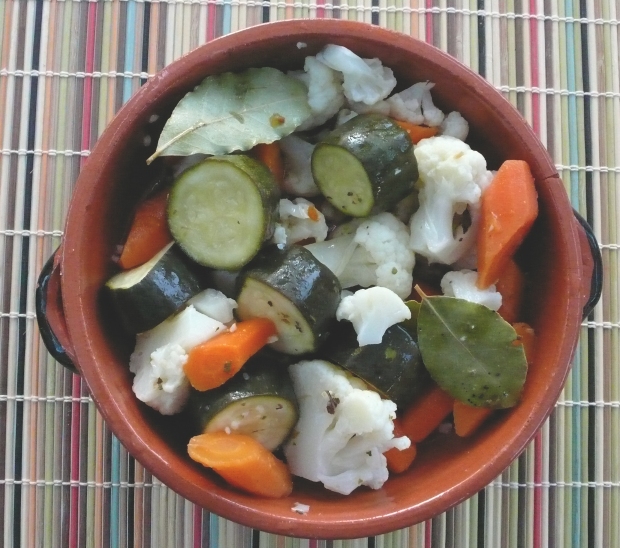
Our first course, with tequila shots; Legumbres en Escabeche (Lightly Pickled Vegetables) from page 143 of the same book, served with chips, tomatillo salsa, and salted roasted almonds.
::
Budín de Elote
Corn Pudding with Roasted Tomato Sauce, a fabulous side dish, adapted from Diana Kennedy. There are many variations of this dish in her books. Some are more cake-like with much more butter and sugar, some are more soufflé-like with beaten egg whites. Some are very cheesy. This is the easiest, and my favorite, which I use, often without cheese, for stuffing the zucchini in “Best-Ever Thanksgiving Side Dish,” which you’ll see by scrolling down.
bread crumbs
1 small bag frozen corn
1/2 cup milk
5 Tb. sweet butter, softened
1 tsp each granulated sugar and salt
3 eggs
1/4 cup grated sharp cheddar cheese
Use on Tb. of the butter to grease a small casserole dish, then coat the inside with bread crumbs.
Pulse corn with milk in food processor until a coarse purée. Pulse in butter, then one egg at a time, then sugar and salt. Spread into prepared dish. Top with grated cheddar. Bake at 350 degrees for about 20 minutes. Serve topped with:
SAUCE: under hot broiler, broil 5 large whole tomatoes, one medium white onion, peeled, and 2 japapeño or serrano chiles until tomato skins are blackened (turn over halfway through, takes about 15 minutes in total). Blend all in food processor until coarse purée, pour into saucepan and simmer gently. Season with salt to taste.
::
Jamie’s Chicken
This is my go-to dish. I saw Jamie Oliver throw this together on TV and explain that you must let it bake slowly until the chicken practically melts from the bone. It stays juicy and has a marvelous texture. I make it when company comes and I don’t want to spend time cooking. I make it on Sunday evenings when I want leftovers for more suppers. I made it for the Buddha Barn potluck with 12 chicken thighs, cut in half, 12 cloves of garlic, and one basket each of red and yellow cherry tomatoes.
8 chicken thighs, skin on
1 basket cherry or grape tomatoes, whole (in season, use half red and half yellow)
large leaves from one bunch basil
6 cloves garlic, skin on
1 tsp coarse sea salt
1/4 cup olive oil
Preheat oven to 350 degrees
Wipe a large shallow baking-serving dish with olive oil and arrange the chicken thighs, excess fat and skin removed, in it. Scatter the tomatoes and garlic cloves on top of the chicken. Sprinkle everything with sea salt and grind on an ample amount of pepper. Lay the basil leaves over the top, covering everything. Sprinkle on the olive oil. Bake, uncovered, for an hour and a half. Stir once, halfway through.
That’s it. The tomatoes soften and collapse and, with the chicken juices, make enough liquid for the chicken to cook to melting tenderness.
For a side dish, bake a pan of quartered new potatoes, also tossed with a little olive oil and salt, alongside, for 45 minutes or so. Note: in the photo above, I added the potatoes halfway through the baking and cooked them along with the chicken so they absorbed the tasty juices.
::
Best-Ever Thanksgiving Side Dish:
Zucchini Stuffed with Corn with Roasted Tomato Sauce
Calabacitas Rellenas de Elote
from Diana Kennedy’s The Cuisines of Mexico, Harper & Row, 1986
From Diana Kennedy—her books and in-person workshops—I learned how to cook with the native foods of the Americas: squash, corn, tomatoes, chiles. And isn’t that what we are supposed to be celebrating on Thanksgiving? At their 1621 autumn harvest feast, the Pilgrims and the Native Americans probably shared those very foods.
This side dish could not be more perfect on the fall-winter table for any occasion. It’s a bit time-intensive, but you can put it all together the day before (like I did this Thanksgiving) and bake it while your turkey is resting. The flavors are just right with turkey and the roasted tomato-ancho sauce is divine over sweet potatoes. You’ll have plenty of leftover rich-earthy sauce, which is also great on chicken, fish, steak….
6 medium zucchini squash or 12 small ones, like the ones pictured here, unpeeled, scrubbed
5 large tomatoes
5 or 6 dried ancho chiles
freshly shredded cheese to measure 1 heaping cup (half asiago and half muenster is very good)
1-lb bag frozen corn
3 eggs
nutmeg, white pepper, salt, sugar, oregano
SAUCE: Broil the tomatoes until they’re blackened all over. (Note: if you’re already feeling overwhelmed, you can use canned tomatoes—Muir Glen Fire Roasted Crushed are good— seasoned with some chili powder or a teaspoon of juice from canned chipotles in adobo. You can also omit the hollowed-out squash and bake the corn custard in a buttered casserole dish with some of the sauce dribbled over and the rest on the side.)
Toast the chiles in a dry frying pan. Tear them open, take out the seeds and stems and soak them in boiling water for about 20 minutes.
While the tomatoes are broiling (and cooling a bit) make zucchini shells by cutting a strip off the top and carving out the centers with a melon ball cutter (the insides can go into a delicious soup). Taking a sliver off the bottom will keep them from rolling around.
CORN CUSTARD: In a food processor, break in the eggs and add the corn, 1/2 tsp salt, 2 tsp sugar, a big pinch nutmeg. Process until the corn kernels are a rough puree. Add the cheese and give the mixture one or two pulses to combine.
SAUCE: Rinse out the food processor and process the soaked chiles and the broiled tomatoes (skin and all) with enough chili-soaking liquid to make a rough-textured but pourable sauce. Pulse in 2 tsp salt, 1/4 tsp oregano, 1 tsp sugar or to taste. You’ll have lots of sauce — enough to drizzle over the stuffed zucchini, serve on the side in a sauce boat, and maybe even some to freeze for another meal (which makes a time-intensive dish like this extra worthwhile).
ASSEMBLY: Lightly oil an attractive shallow baking/serving dish. Spread a little sauce around the bottom. Fill the zucchini shells with the corn mixture and arrange in the dish. Drizzle a little sauce across the top.
Cover the dish with foil (at this point it can be refrigerated overnight). Preheat oven to 350 degrees. 40 minutes or so before serving, bake, covered for 1/2 hour, uncover for the last 5 minutes. Simmer the sauce separately and serve it in a sauceboat.
::
The World’s Best Fresh Tomato Sauce
Adapted from The Geometry of Pasta, by Caz Hildebrand, a London-based graphic designer of chic identities and products, and Jacob Kenedy, the Italian-British chef at the restaurant voted “London’s best.”
Make this sauce in August from juicy, ripe fresh tomatoes from a farm stand or garden. It is so simple, improbable, and good. Make it the rest of the year with the best tomatoes you can find.
2 large garlic cloves, very thinly sliced
3 to 4 Tb extra-virgin olive oil
6 large red tomatoes or 12 plum tomatoes (3 lbs)
1/2 tsp sea salt and freshly ground pepper to taste, big pinch of sugar
a few thin pats of unsalted butter
shredded fresh basil leaves
wedge of Parmesan cheese with hand grater such as Microplane
Core the tomatoes and puree in the food processor, skin, seeds and all. Heat the olive oil in a medium saucepan and sauté the garlic for 30 seconds (don’t let it turn brown or burn) and slowly pour in the tomato puree. Season well. Cook over low heat, stirring occasionally, for about 15 minutes or until slightly thickened.
Adjust seasoning. Mix a little sauce into your hot cooked pasta. Plate the pasta, and top each serving with a big spoonful of the sauce, more freshly ground pepper, a thin pat of butter and a big sprinkle of shredded basil. Diners grate cheese over their portions to taste.
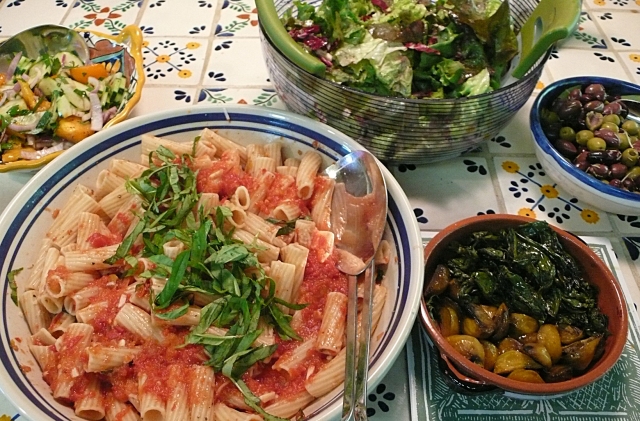
Rigatoni with fresh tomato sauce, as served last Tuesday with yellow tomato and cucumber salad, roasted yellow baby beets with sauteed beet greens, mixed lettuce salad, and olives with rosemary. All fresh vegetables from Harlow Farm.
::
Quik Zucchini Frittata
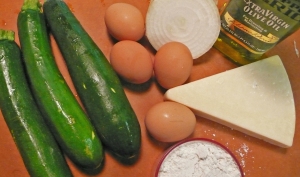 I’ve been making zucchini frittata for years, using an old Sephardic recipe that calls for “one potato, mashed’ to hold it together. I recently enjoyed a delicious version made by Marsha Millman of Greenport, NY. ‘USE a cup of Bisquik,’ Marsha explained. ‘Saves peeling, boiling and mashing a potato, and the leavening in the Bisquik gives it a nice lift.’ Here is the version I made the next night, with zucchini from a North Fork farm market.
I’ve been making zucchini frittata for years, using an old Sephardic recipe that calls for “one potato, mashed’ to hold it together. I recently enjoyed a delicious version made by Marsha Millman of Greenport, NY. ‘USE a cup of Bisquik,’ Marsha explained. ‘Saves peeling, boiling and mashing a potato, and the leavening in the Bisquik gives it a nice lift.’ Here is the version I made the next night, with zucchini from a North Fork farm market.
3 medium to largish zucchini, unpeeled, scrubbed
1/2 medium onion
3 oz. Asiago cheese
5 eggs
1 cup Bisquik
3 Tb. olive oil
1 large clove garlic, mashed through garlic press
2 Tb. minced parsley
1 tsp salt
1/4 tsp white pepper
Preheat oven to 350 degrees. With large grating disk of food processor, grate zucchini, onion, and cheese. In large mixing bowl, whisk eggs. Stir in grated ingredients, mashed garlic, Bisquik, parsley, salt and pepper, and 2 Tb. of the EVOO. With the remaining oil, grease a shallow casserole dish well. Pour in the mixture and smooth the top. Grate a little more cheese on top, if you like.
Bake for 1/2 hour, then set the casserole under the broiler for a few minutes, watching carefully, to brown the top. Let the dish stand for 5 minutes before cutting into squares.
At the farm market we also got some local lettuces and a bunch of tiny beets. The beet greens looked so fresh, they begged to be eaten too. I washed and tossed with a bit of EVOO, put the scrubbed beets on top, and baked the pan alongside the frittata. It was a delicious, if not photogenic, accompaniment.
::
Valencia Orange Cake
Maida Heatter’s Book of Great Desserts was a title I didn’t own until enjoying the most delicious cake in California. It was lovely to look at, moist and delicate. Made by a friend and neighbor of our hosts, using oranges from her own tree and her marvelous homemade marmalade, it was baked in a gugelhupf mold, something I’ve inherited from my grandmother that decorates my kitchen but never used—until now. I’m sure it will taste wonderful made with store-bought oranges and marmalade.
2 ½ cups sifted all-purpose flour
1 Tb + 1 tsp double-acting baking powder
¼ tsp salt
½ lb (2 sticks) unsalted butter, room temperature
1 ½ cups sugar
2 eggs, separated, + 3 egg yolks
grated rind of two oranges
2/3 cup juice squeezed from the oranges
Preheat over to 350 degrees. Butter the gugelhupf mold (or 9 x 3 ½” tube pan) and dust with fine, dry breadcrumbs.
Sift the dry ingredients together onto a piece of waxed paper. In large mixing bowl, cream the butter, add the sugar and beat with electric mixer for 2 to 3 minutes. With mixer running, add the egg yolks one at a time. On low speed, add the dry ingredients one-third at a time alternately with the orange juice, scraping bowl after each addition. Stir in the orange rind.
In clean bowl with clean beaters, beat the egg whites until they hold firm peaks and fold into the batter. Turn the batter into the prepared pan and level off.
Bake one hour or until cake tester comes out clean. Cool in pan about 20 minutes. Cover with a rack and invert. Remove pan and glaze with ½ cup orange marmalade briefly boiled with 2 Tb. water.
::
Elena’s Tostadas and Tortas
Enjoy the rich and earthy flavors we savored on our trip to Isla Mujeres without going through airport security and passport control. It’s easy to make these antojitos (snacks) at home. Have all the components ready to assemble when the rolls or fried tortillas are piping hot.
YUCATÁN PICKLED ONIONS
1 medium red onion, cut in thinnest possible rings
1/4 cup white vinegar
1 cup water
a few whole black peppercorns
Several hours or the day before assembling the tostadas or tortas, mix together the vinegar and water. Add the onions and place in the fridge, covered, until they turn iridescent magenta. These will keep for up to two weeks and are great to serve with grilled steak or chicken.
CHEESE
1 8-oz package farmer cheese
1 small onion, chopped fine
1/3 cup grated Parmesan cheese
I learned this as an enchilada filling at a workshop with Diana Kennedy, and it’s an excellent proxy for sharp white Mexican cheese. Salt to taste.
GARNISH
1/4 cup cilantro, chopped
1 cup green tomatillo salsa (Frontera brand is good, or home-made)
1 avocado
1/2 cup red radishes
Mix the cilantro into the salsa and set out in a nice bowl. Thinly slice the avocado
and radishes.
ASSEMBLY
1 15-oz can refried beans, preferably nonfat
6 hard-crusted, yeasty rolls, split lengthwise and toasted
OR
12 corn tortillas, fried until crisp in hot corn oil
OR
12 packaged, pre-fried tostadas, heated in oven
Heat the beans in a small saucepan, adding a few spoonfuls of water to get them to spreadable consistency. If making tortas, remove the inside crumb from the rolls before toasting under the broiler for a few seconds. Spread the hot rolls or fried tortillas with the beans. Crumble the cheese over the top. And, of course, if you want non-vegetarian tostadas or tortas, you can add shredded poached chicken, grilled shrimp, or any other topping. Just no hamburger meat sauteed with taco seasoning. Dribble the salsa over everything and top with the picked onions, radishes, and avocado slices (I hope you can find better avocados than the one I bought the day the picture above was taken). Serve immediately.
PS: These days you can eat fresh vegetables and fruits in Mexico, at least in tourist areas. Produce is routinely washed with purified water.
::
Farfalle con Zucchine e Pignoli
A quick, delicious dish adapted from The Geometry of Pasta, by Caz Hildebrand and Jacob Kenedy. I recently had the pleasure of interviewing Caz and Jacob for the online magazine Imprint. You can look inside the book and see every pasta shape diagrammed in black and white at http://imprint.printmag.com/graphic/the-designer-and-the-chef-behind-the-geometry-of-pasta/
1/2 lb farfalle (butterfly pasta, known in the U.S. as bow ties)
3 medium zucchini, scrubbed and sliced less than 1/4″ thick
3 Tb olive oil
2 cloves garlic, thinly sliced
1/2 lemon, zest and juice
1/3 cup pine nuts, lightly toasted in a small, dry frying pan
1/2 cup basil leaves, shredded
Bring pasta water to the boil. While the farfalle are attaining al dente consistency, heat the olive oil in a large frying pan and fry the zucchini slices on both sides. Do this in two or three batches so the slices remain in one layer. Remove to paper towels when they’re lightly browned and tender. When the last few are almost done, return all the zucchini to the pan and stir in the garlic, lemon zest, lemon juice, and pine nuts. Add a scant ladleful of pasta water, and toss in the farfalle, which by then will have been drained. Toss again with the basil and freshly ground black pepper, and serve with lots of grated Parmesan.
::
Braised Bean Curd with Chinese Cabbage and Mushrooms
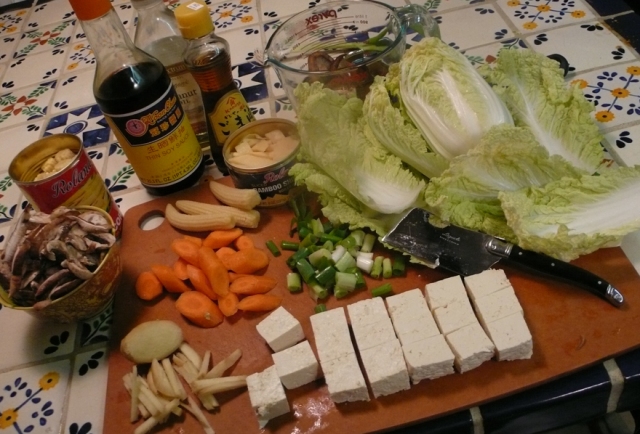 My son Alex, who lives in China, took my husband Julius and me to a Beijing restaurant that specializes in casserole dishes of the Hakku minority people. With every bite I realized that braised dishes could be one of the most satisfying ways for Westerners to enjoy Chinese food at home. This recipe—perfect to make on a cold, snowy day like today—was adapted from The Food of China by Deh-Ta Hsiung and Nina Simonds, a book of accessible recipes and dramatic photography, which is as worth exploring as the Asian market where you’ll find the ingredients.
My son Alex, who lives in China, took my husband Julius and me to a Beijing restaurant that specializes in casserole dishes of the Hakku minority people. With every bite I realized that braised dishes could be one of the most satisfying ways for Westerners to enjoy Chinese food at home. This recipe—perfect to make on a cold, snowy day like today—was adapted from The Food of China by Deh-Ta Hsiung and Nina Simonds, a book of accessible recipes and dramatic photography, which is as worth exploring as the Asian market where you’ll find the ingredients.
8 dried Chinese mushrooms
8 – 10 leaves Chinese cabbage
12 oz extra-firm bean curd (tofu), cut into one-inch squares
2 Tb peanut or vegetable oil
2 medium carrots, peeled and cut on the diagonal
8 oz fresh mushrooms, wiped clean and cut in half
one can Chinese whole baby corn
one can bamboo shoots
Soak the dried mushrooms in ½ cup boiling water. Meanwhile, line a large flameproof casserole or Dutch oven (with lid) with the cabbage leaves. Shred the rest of the cabbage and place atop the whole leaves. Pat the tofu dry with paper towels. Heat the oil in a frying pan (not a wok, you need a flat surface). Fry the tofu until lightly browned, carefully turn over and brown the other side. Place the tofu squares on top of the shredded cabbage leaves. Lightly sauté the carrots and mushrooms in the oil left in the pan and add to the casserole along with the soaked, dried mushrooms (save the soaking water). Drain the baby corn and bamboo shoots and add to the casserole, which will be packed (everything will cook down).
BRAISING LIQUID
1/2 cup mushroom soaking water, strained
1/2 cup light soy sauce
2 Tb Shaoxing rice wine
3 Tb fresh ginger, minced
Whisk the above together in a small bowl and pour over everything. Cover the casserole tightly and simmer on the top of the stove over low heat for 20 minutes.
Do not stir.
GARNISH
4 scallions, chopped
2 tsp roasted sesame oil
 For the last five minutes of cooking, top the ingredients with the scallions. Before serving, sprinkle with sesame oil. Serve with steamed rice, and for an extra-festive dinner, with half a roast duck or soy-sauce chicken from the takeout department.
For the last five minutes of cooking, top the ingredients with the scallions. Before serving, sprinkle with sesame oil. Serve with steamed rice, and for an extra-festive dinner, with half a roast duck or soy-sauce chicken from the takeout department.
::
Farm Market Succotash Salad
This colorful crowd-pleaser in adapted from a recipe in a fancy Hamptons magazine. I made it (mostly) from ingredients from Hayground Market in Bridgehampton.
1 lb. green beans, trimmed
1 lb. yellow wax beans, trimmed
6 ears corn, kernels cut from cobs
1 basket grape tomatoes, cut in half
1 bag frozen shelled edamame beans
1 small red onion
1/4 cup basil leaves, shredded
Vinaigrette made from olive oil and wine vinegar seasoned with salt, freshly ground pepper, and a touch of honey.
Bring a large pot of salted water to the boil. Cook edamame for 5 minutes and remove with large slotted spoon or Chinese skimmer. Place in colander, refresh under cold water, and place in very large salad bowl. Boil green and yellow beans in the same pot until tender but still crisp and add to bowl. If corn is very tender, add it to the bowl raw; if not, blanch for 1 minute. Add tomatoes, onions and basil, and toss together with enough vinaigrette to moisten and more fresh herbs, if you like. Check seasoning and enjoy.
::
P’s Rainbow Chard
Swiss chard with garlic and tomato was one of the first homemade Italian dishes I’d ever tasted, at the Santa Monica home of my college friend Bobbi Pizzimenti, whom we called “P.” Home isn’t the right word—it was more like crash pad and communal hangout for music listening, cooking and eating. I learned to cook at P’s table, and never forgot this dish, which couldn’t be simpler or more delicious.
One large bunch Swiss, ruby, or rainbow chard
3 Tb. olive oil
2 cloves garlic, thinly sliced
1/2 cup ripe tomatoes, peeled and chopped fine, or marinara sauce
Cut the thick stems and ribs from the center of chard leaves, wash them, and cut into one-inch pieces. Heat the olive oil and slowly sauté the ribs until they are almost tender, about 10 minutes, salting them lightly. While the ribs are cooking, wash the leaves well and slice into one-inch ribbons. Add the leaves and the garlic to the ribs, stir, and allow to cook down a bit. Add the tomatoes or marinara sauce and cook until the ribs are very tender. This dish should not be al dente; the color won’t be as pretty, but the taste will be satisfyingly rich and earthy.
::
Crudo with Fresh Basil
In Portovenere, Italy, we splurged on lunch at a splendid restaurant, Le Bocche (the name of the seafront, awkwardly translated as ‘the mouths’). With chic, minimalist décor and a stunning view of the harbor from the outdoor tables, it was the perfect place to eat a wonderful meal while watching the boats come and go and the local kids playing and sunning themselves on the rocks.

Crudo of scallops with fresh basil from my garden, served on a plate from Casafina Warehouse Sale, Brewster, NY.
As my primo piatto, with Cinque Terre white wine, I ordered crudo, paper-thin slices of marinated raw fish. I’d heard Mario Batali talk about this Italian answer to sashimi, but had never tried it. You must make this tonight. Needless to say, you need the freshest fish, a really sharp knife, and the best olive oil. I made it with scallops, and will try it soon for a larger crowd with tilapia. The proportions below serve two as an appetizer.
6 large sea scallops
2 tablespoons extra-virgin olive oil
2 tablespoons freshly squeezed lemon juice
a few fresh basil leaves, very finely shredded
sea salt and grinder with black or mixed peppercorns
To make the scallops firmer and easier to slice, freeze them for about an hour. On an impeccably clean board, cut them into 1/8” slices and arrange on a platter. Whisk together the olive oil and lemon juice and dribble over the scallops are they are well coated and reposing in the barest little pool of oil. Do not handle, mix, etc. Sprinkle with the basil shreds, a bit of salt, a few grindings from the pepper mill. Let marinate for 10 minutes or so and enjoy.
::
Renee’s Vegan Fruit Cobbler
My friend Renee is renowned for her pies, cakes, tarts, and cookies, but especially for her fruit crisps and crumbles. We enjoyed this cobbler from fresh peaches from her garden. Because her son Noah is vegan, Renee has adopted many recipes to be dairy-free. You’d never know.
CRUMBLE
1 cup brown sugar
1 cup flour
1/2 cup (1 stick) vegan margarine (such as Earth Balance)
1 cup chopped pecans
FRUIT FILLING
8 cups sliced peaches, or combination of peaches and blueberries
2 Tb. flour
2 Tb. granulated sugar
Mix together filling ingredients (you may want to peel peaches by dropping in boiling water for a few seconds and slipping off skins) and divide between two greased 8-inch square baking pans. Mix together crumble and top the fruit filling. Bake for one hour at 350 degrees.
PS: I was ready to make this last night, non-vegan, with unsalted butter in the topping. I got as far as blanching the peaches and sprinkling them with a little sugar-in-the raw. They were so good, no topping or baking was needed. We ate them just like that.
::
Pesto, Ligurian Style
Pasta with pesto is ubiquitous on the NYC salad bar and buffet table. And it’s usually awful: too strong, bitter, dry.
We ate very, very well on Italy’s Ligurian coast, where Trofie al Pesto is a primo piatto on almost every menu. Trofie are small, hand-twisted pasta spirals, and the pesto there was a revelation: delicate, silky, creamy. Each restaurant makes the dish a little differently: sometimes with a few green beans or pieces of boiled potato mixed in, sometimes with whole pine nuts adding crunch. They don’t skimp on the olive oil. But the key, I learned from several books on my shelves at home, is the basil itself: the Ligurians make it with tiny-leaved varieties that don’t have a hint of minty taste.
Could I duplicate the experience at home with our large-leaved, coarse, minty basil? I bought a big bunch at Stew Leonard’s, and am happy to report that the answer is yes. The real secret, I learned from Enchanted Liguria by David Downie (Rizzoli, 1997) is a touch of ricotta, which smoothes out the dish and gives it richness without too much oil.
If you can’t find trofie — and I could only find it in the tourist shops in Liguria; the supermarkets that cater to locals stock the same Barilla pasta sold here — you can use any fresh pasta, like linguini, or the small dried pasta of your choice.
Here’s how I made it last night:
1 large bunch basil (leaves only, no stems) washed and spun dry (about three loosely packed cups)
1 medium clove garlic, chopped
1/3 cup pine nuts, divided
1/3 cup olive oil
½ cup coarsely and freshly grated Grana Padano cheese; you could also use Parmigiana-Reggiano or Sardo
¼ cup ricotta
Pulse the basil, garlic and half the pine nuts in the food processor with about a third of the olive oil, scraping down the sides of the bowl. Add the rest of the oil in a stream, then the grated cheese. Do all this in a few seconds so the pesto doesn’t get over-blended. Add the ricotta and the rest of the pine nuts with a few quick pulses, leaving some of the pine nuts whole.
Mix into hot pasta. Use this sauce sparingly! One heaping tablespoon is plenty for two generous servings of pasta.
The pesto will keep, tightly covered in the fridge, in a non-metallic container with a film of olive oil on top, for several days. Or freeze in small containers.
::
Iced Tiramisù Coffee Dessert
During an excursion to Sestri Levante, on Italy’s Ligurian coast, my husband and I stopped to cool off at a bar that featured an intriguing list of coffee drinks. What was Tiramisù coffee, I wondered. It sounded kind of terrible, but the barista assured me it was one of the best things she makes, and it had vanilla gelato in it. It was blazingly hot, and any way to get a little more gelato in me would not be a bad thing.
This drink-dessert was the best thing we had on the whole trip (and we ate really, really well). The only problem is what to call it: a smoothie, a semi-freddo, a slushy, a frappé? It’s the texture of a milkshake and you can spoon it or sip it.
Here is the recipe for two servings, courtesy of Mammaluna Caffè, Sestri Levante:
6 ladyfingers (sponge biscuits)
2 demitasse cups strong espresso coffee (or 2 heaping teaspoons instant espresso powder dissolved in ½ cup boiling water), cooled
2 shots (4 Tb.) Marsala wine (or less per your taste)
6 small scoops vanilla gelato or ice cream
cocoa powder
Break up ladyfingers and place in blender jar with espresso, Marsala and gelato. Blend. Pour into glasses and freeze for about an hour until it sets up and gets a few ice crystals. Sift cocoa powder on top.


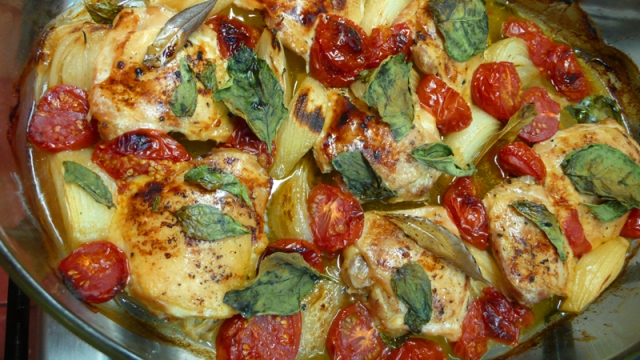

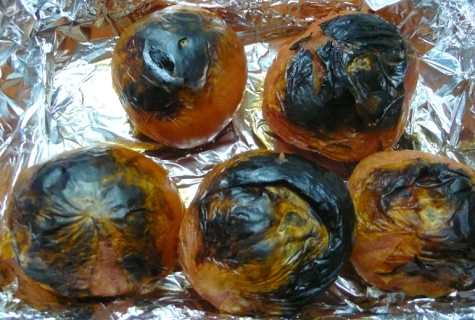

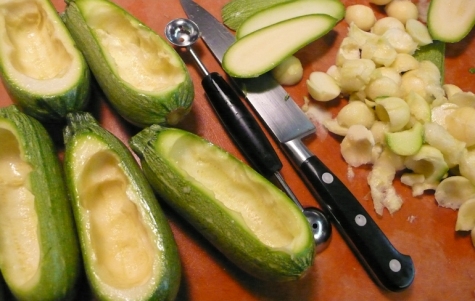

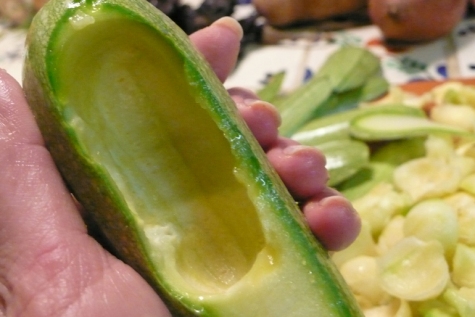
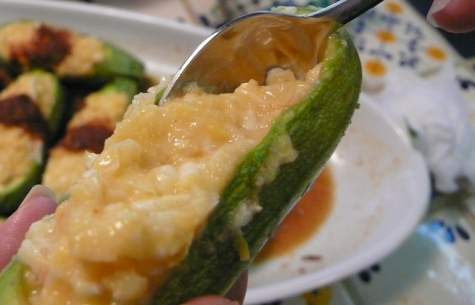
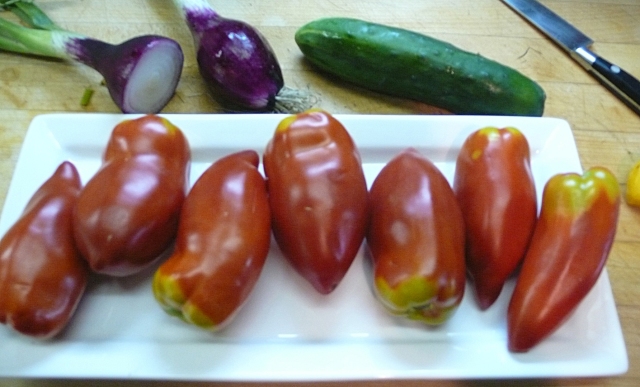
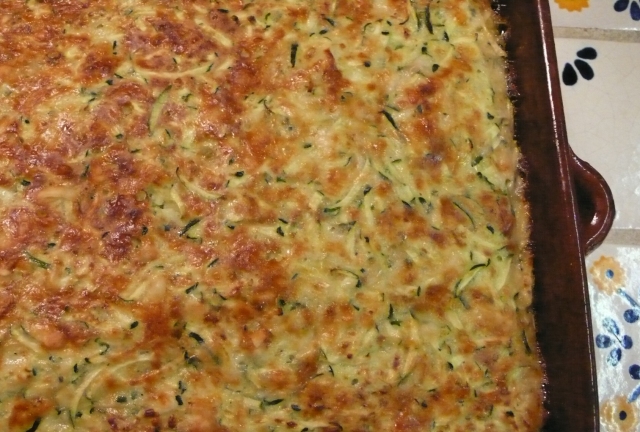

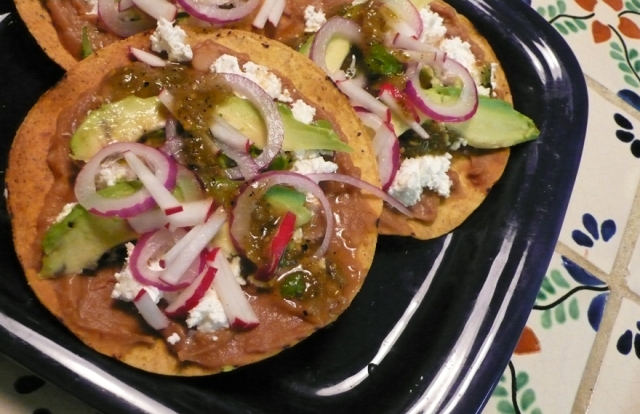
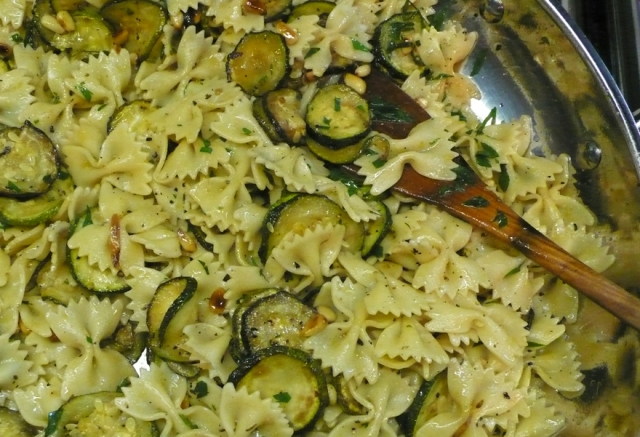
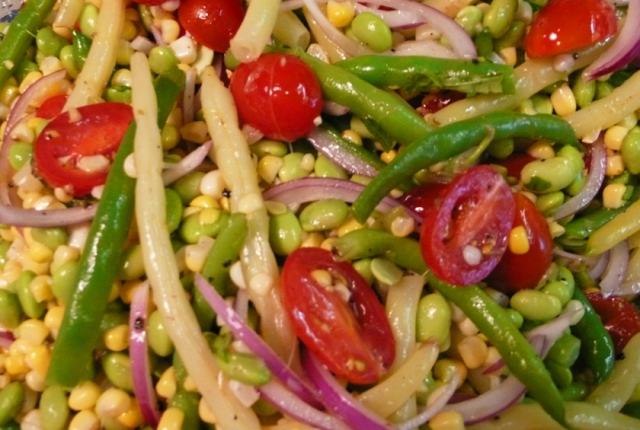



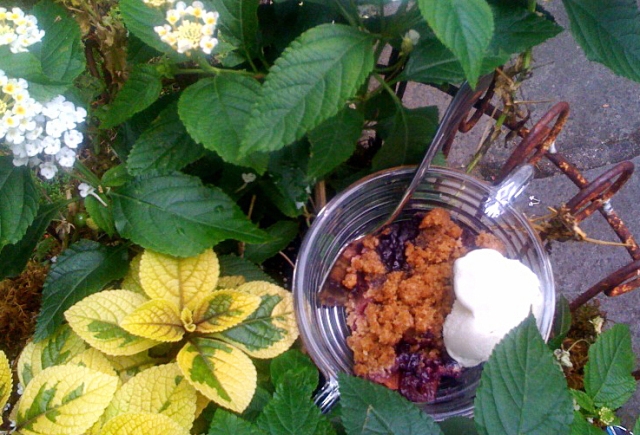

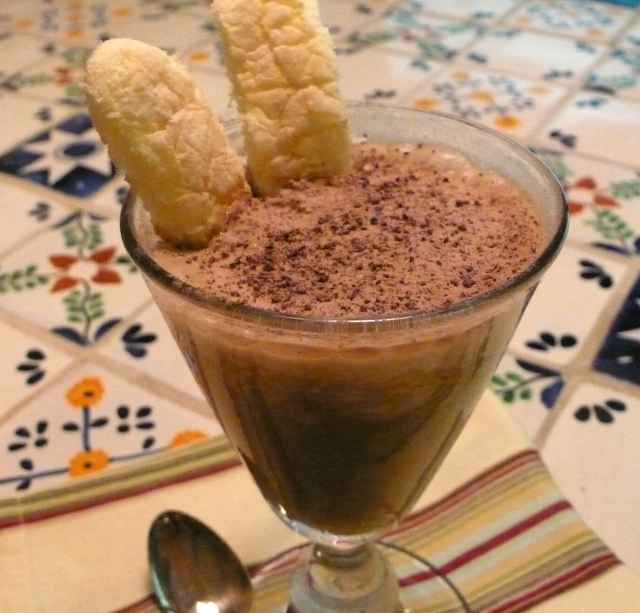

Pingback: Not Just Another Farm Stand |
Pingback: And They Had a Buddha Barn Party |
Pingback: Best-Ever Holiday Side Dish | Dig-It-Blog.com